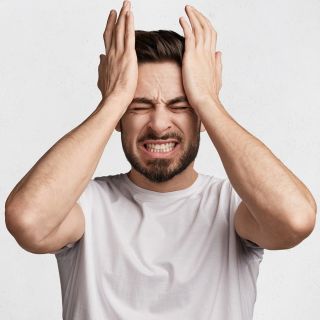Depression
What Is Masculine Depression, and How Is It Treated?
Masculine depression is associated with alcohol and drug abuse.
Posted June 29, 2024 Reviewed by Ray Parker
Key points
- Masculine depression is a subtype of depression that is more common in but not exclusive to men.
- Masculine depression is associated with externalizing symptoms such as aggression and risk-taking behaviors.
- Individuals with masculine depression rarely seek help, preferring to self-medicate with drugs and alcohol.

Published in the European Archives of Psychiatry and Clinical Neuroscience, a recent study by Zimmermann and colleagues sheds light on “masculine depression.”
What is masculine depression?
Sex and gender influence the genesis and manifestation of many diseases, including psychiatric illnesses such as depression.
For instance, research commonly shows that women are more likely than men to be depressed. Why? A number of explanations have been offered, some focusing on biological factors (puberty, premenstrual problems, pregnancy, menopause) and others on the environment (gender gap in social status, earnings, and workload).
But what if the observed gender difference in the prevalence of depression has to do with mood disorders often presenting differently in men?
Indeed, when researchers use gender-specific screening tools, such as the male depression risk scale 22 (MDRS-22), they tend to find a much higher prevalence of depression in men.
MDRS-22 assesses what is called masculine depression. Masculine depression differs from the classical presentation in important ways. It emphasizes externalizing symptoms such as aggression, avoidant behaviors, emotional suppression, risk-taking, and self-medicating with drugs.
Note that masculine depression is not the same as male depression (i.e., it does not refer to a mental illness that occurs only in men). It is a subtype of depression, which means women may receive the diagnosis too.
Masculine depression is more likely to occur in women who assume male gender roles, for example, in single mothers exposed to the chronic stress of trying to pursue a career while raising a family alone.
Indeed, adherence to “typically masculine norms” appears to be a major risk factor for masculine depression. Some examples of these norms are:
- Dominance and power
- Emotional control
- Primacy of work
- Overwork (50 or more hours per week)
- Risk-taking
- Self-reliance
- Unwillingness to seek help
- Substance use/abuse
- Violence/aggression
- Success
For instance, in people who endorse the norm of emotional self-control, expressing feelings freely is often a major threat to their sense of competence and social status.
A study of masculine depression
Zimmermann et al. examined whether masculine depression is associated with certain factors of interest, such as substance abuse. They investigated whether the use of drugs and health services differs between patients with and without masculine depression (as measured by MDRS-22).
A sex-balanced cohort of inpatients and healthy controls was recruited for this open-label prospective study. Participants were classified as having non-masculine depression (82 participants) or masculine depression (81 participants).
The two groups were subsequently compared with a group of healthy controls (176 participants).

Analysis of data showed that participants with masculine depression were younger than those with non-masculine depression, worked more hours, were less likely to be married, and had higher depression scores.
Higher scores on the MDRS-22 correlated with a lower rate of sedative use, higher severity of depression and substance use, and “more critical use patterns of alcohol, tobacco, cannabis, and hallucinogens.”
In addition, both men and women with masculine depression reported less mental health-related use of medical and psychiatric services despite having more problematic substance use patterns (e.g., higher binge drinking).
The Male Depression Risk Scale (MDRS-22)
To give you a better idea of how male depression is assessed, here is the MDRS-22 scale:
MDRS-22 Instructions: During the previous month, how often did each of the following happen? Assign a number: 0 = not at all, 3 = just under half the time, 4 = just over half the time, and 7 = almost always.
1. I bottled up my negative feelings.
2. I covered up my difficulties.
3. I drank more alcohol than usual.
4. I drove dangerously or aggressively.
5. I had more heartburn than usual.
6. I had regular headaches.
7. I had stomach pains.
8. I had to work things out by myself.
9. I had unexplained aches and pains.
10. I needed alcohol to help me unwind.
11. I needed to have easy access to alcohol.
12. I overreacted to situations with aggressive behavior.
13. I sought out drugs.
14. I stopped caring about the consequences of my actions.
15. I stopped feeling so bad while drinking.
16. I took unnecessary risks.
17. I tried to ignore feeling down.
18. I used drugs to cope.
19. I verbally lashed out at others without being provoked.
20. I was verbally aggressive to others.
21. It was difficult to manage my anger.
22. Using drugs provided temporary relief.
The risk of depression depends on the sum of the scores: 0 – 31 = low risk; 32 – 50 = elevated risk; 51 – 86 = high risk; 87 or higher = extreme risk.
(Note: this scale is being shared for educational purposes only. If you suspect that you have depression, please see your healthcare provider for assessment and treatment.)
Takeaway
Masculine depression is a proposed subtype of depression.
The study reviewed found that masculine depression is associated with the following:
- More critical and frequent use of tobacco and alcohol (e.g., binge drinking).
- More critical and frequent use of illicit drugs (e.g., hallucinogens).
- Lower use of mental health services.
These results are not surprising, given that this subtype of depression is related to male gender roles and masculine norms—emphasizing aggression, dominance, risk-taking, overwork, self-control, success, and self-reliance.
People who follow these norms believe real men do not get depressed. Or that becoming workaholics, abusing drugs and alcohol, and even considering suicide are more acceptable ways of dealing with unhappiness than seeking mental health treatment.
This is a dangerous mindset.
If you or someone you love is contemplating suicide, seek help immediately. For help 24/7, dial 988 for the National Suicide Prevention Lifeline, or reach out to the Crisis Text Line by texting TALK to 741741. To find a therapist near you, visit the Psychology Today Therapy Directory.




